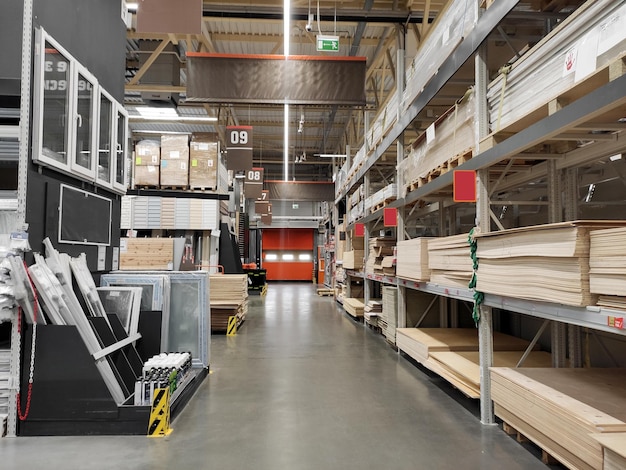Discover the hidden truths about construction material selection that could save you thousands – and prevent costly mistakes most homeowners make.
Understanding the Hidden World of Construction Materials
In today’s complex construction landscape, making informed decisions about building materials can mean the difference between a lasting investment and a costly nightmare. Recent studies show that over 35% of UK construction projects exceed their budgets due to poor material selection. The reality is that while most builders are knowledgeable, they may not always share the full picture about material options, costs, and long-term implications. Understanding these crucial details can save property owners significant amounts in both immediate and future expenses.
The Foundation of Every Build: Core Materials Decoded
The cornerstone of any construction project lies in its fundamental materials. Recent industry data reveals that concrete, steel, and timber account for approximately 75% of all construction material costs in the UK. Making informed choices about these core materials is essential for project success and long-term durability.
Concrete: Beyond the Basics
Many builders won’t tell you that concrete quality varies significantly beyond simple strength grades. The key lies in understanding the mix design – while a standard C25/30 grade might seem sufficient, factors like water-cement ratio and aggregate quality can dramatically impact durability. Studies show that properly specified concrete can last up to 50% longer than standard mixes. Here’s what you need to know:
- Different exposure classes require specific concrete grades – XC for carbonation resistance, XS for marine environments
- The water-cement ratio significantly affects durability – lower ratios generally mean better quality
- Aggregate size and quality impact strength and workability
- Chemical admixtures can enhance performance but may affect long-term durability
Steel Selection Secrets
Steel specification is often oversimplified in construction projects. The truth is that choosing the right grade and coating can extend structural life by up to 30 years. Key considerations include:
- S275 vs S355 grade selection – higher grades aren’t always better
- Hot-dip galvanizing offers superior protection compared to painting
- Connection details matter more than overall steel grade
- Environmental exposure should dictate coating specifications
Timber Types and Treatment
The timber industry holds many secrets, particularly regarding treatment levels and moisture content. Nearly 40% of timber-related building issues stem from incorrect specification or inadequate treatment. Essential knowledge includes:
- UC4 treatment is essential for ground contact – many builders use UC3 to cut costs
- Moisture content should be below 20% for most applications
- European softwood grades vary significantly – C24 isn’t always necessary
- Treatment certificates should always be provided and verified
Modern Materials: Innovation vs. Traditional Choices
The construction industry is experiencing a revolution in material technology. Recent data shows that innovative materials can reduce building costs by up to 20% while improving performance. However, not all new materials live up to their promises, and traditional options often remain the most practical choice.
Self-healing Concrete and Smart Materials
While these technologies show promise, their real-world application requires careful consideration. Performance data indicates:
- Self-healing concrete costs 2.5 times more than traditional concrete
- Smart materials can reduce maintenance costs by up to 40%
- Integration with existing systems requires specialist knowledge
- Long-term performance data is still limited
Sustainable Options
Sustainability in construction materials isn’t just about environmental impact – it’s about long-term value. Sustainable materials can reduce energy costs by up to 30% over a building’s lifetime. Key considerations include:
- Recycled content percentages and their impact on performance
- Embodied carbon calculations and their significance
- Local sourcing benefits and limitations
- Certification requirements and costs
Material Compatibility and Common Pitfalls
One of the most overlooked aspects of construction is material compatibility. Industry studies show that 25% of building failures result from incompatible material combinations. Understanding these interactions is crucial for long-term success.
Weather Resistance and Regional Considerations
The UK’s unique climate demands specific material considerations. Recent data shows that inappropriate material selection for local conditions leads to £3.5 billion in annual repair costs. Critical factors include:
- Exposure zones and their impact on material selection
- Frost resistance requirements for external materials
- Driving rain indices and appropriate detailing
- Coastal considerations and salt exposure
Cost vs. Quality: Making Informed Decisions
The true cost of construction materials extends far beyond their purchase price. Analysis shows that choosing higher quality materials can reduce lifetime costs by up to 40%. Consider these factors:
- Initial cost vs. maintenance requirements
- Expected service life and replacement cycles
- Installation costs and complexity
- Future availability for repairs and matching
Expert Tips for Material Selection
Professional insights can help navigate the complex world of construction materials. Here’s what industry experts recommend:
Building Regulations and Material Standards
Compliance isn’t optional, but understanding the regulations can lead to better material choices. Updates to Building Regulations in 2024 have introduced stricter requirements for material performance and documentation.
Material Sourcing Strategy
Effective sourcing can significantly impact project success. Consider these strategies:
- Research multiple suppliers and compare quality standards
- Request samples and test certificates
- Verify chain of custody documentation
- Consider bulk purchasing for better rates
Making the Right Choice: Your Action Plan
Success in material selection requires a systematic approach. Begin by documenting your project’s specific requirements, consulting with qualified professionals, and creating a detailed specification. Remember that proper material selection can reduce project costs by up to 25% while extending service life by decades. Always verify certifications, request samples, and consider long-term maintenance requirements before making final decisions.
Sources
[1] https://www.autodesk.com/blogs/construction/common-construction-materials/
[2] https://en.wikipedia.org/wiki/Building_material
[3] https://structuralengineeringbasics.com/what-types-of-construction-building-materials/


Leave a Reply